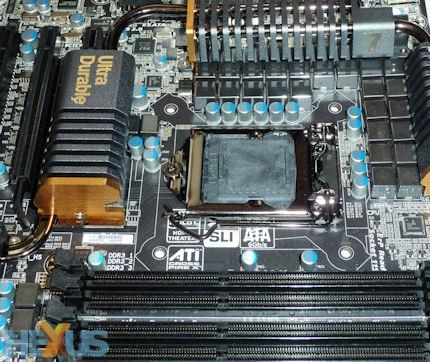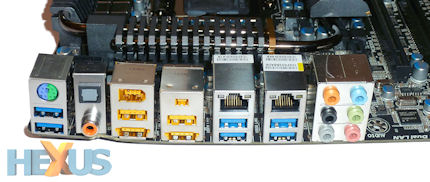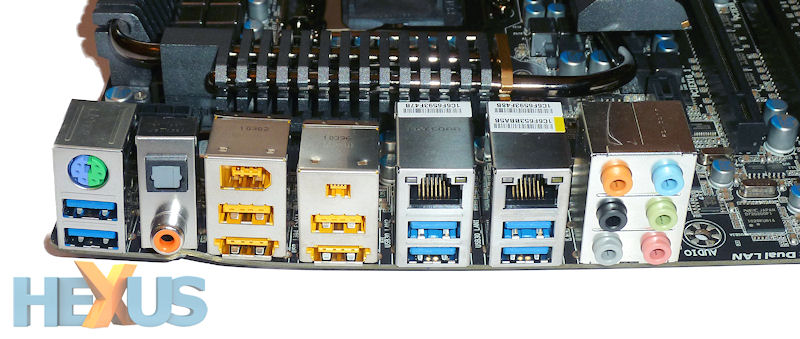Intel's new range of processors, dubbed Sandy Bridge, is still at least a month off from being made public, and it's no secret that the performance Sandy Bridge chips will ship with Core i3, Core i5 and Core i7 2000-series names. The architecture differences between these new LGA1155 chips and incumbent LGA1156 Lynnfield processors - which are eventually to be replaced by Sandy Bridge - means Intel is bringing a new range of supporting core-logics to market.
Raising the P67 standard
Gigabyte provided HEXUS with a P67 chipset-based motherboard in the form of the P67A-UD3, which we took a close look at here. Aimed at the mainstream market and due to come in at around £100 we reckon it's a reasonable bet. But P67 boards can be packed to the gills with features, should a manufacturer so wish, and this is exactly what Gigabyte is doing with the P67A-UD7. Promising the best Sandy Bridge experience going, Gigabyte was only too keen to send in the board for our perusal.
Say hello to my little friend
Gone is the blue-and-white colour scheme of the 'UD3, replaced by a cool-looking black aesthetic that gives the board a premium feel. The film buff in us can't help thinking that Gigabyte's engineers have been watching Scarface a few too many times, paying homage to Tony Montana's black-and-gold throne.
Designed for the enthusiast, the 'UD7 includes on-PCB power, reset and clear CMOS buttons, located near the 24-pin power connector. We'd like them nearer the bottom of the board, making access simpler if installed in a chassis, but this isn't really an issue as most die-hard overclockers tend to benchmark their systems with an open-air setup.
Zooming in on the CPU socket, the LGA1155 socket is surrounded by a 24-phase supply, which can negotiate down to a 12-phase mode when in 'normal' mode. All 24 phases can be activated in the BIOS when pushing components to the limit.
Chunky monkey
Much like the 'UD3, there's adequate clearance around the socket to mount large-ish coolers. The heatsinks, which are screwed in rather than attached by push-pins, are significantly chunkier than those found on the cheaper model, and they push up the board weight to 1,249g - or over 300g heavier than the 'UD3. The four DIMM ports support dual-channel memory operating at speeds of up to 2,133MHz, by the way.
On top of the quartet of SATA 3Gbps, the P67 chipset adds in its own SATA 6Gbps ports, shown here in white. The two SATA 6Gbps ports on the right, which aren't present on the cheaper 'UD3 board, are powered by a Marvell chip. The 'UD7 also adds in a debug LCD display - aiding POST-related trouble-shooting if you've pushed the components too far.
Catering for the enthusiast means adding in more mechanical x16 PCIe slots for multi-card graphics. Gigabyte has four such slots on this model, split by a conventional PCIc in the middle. We know that the Sandy Bridge CPU provides a scant 16 lanes, which is not nearly enough for the slots, so Gigabyte has specified the NVIDIA NF200 bridging chip to expand the PCIe laneage.
Four-way CrossFireX
Jumping on the back of the CPU's PCIe lanes, the NF200 chip multiplexes them such that all four slots receive a x8 link. Bear in mind that, no matter how many lanes the NF200 provides, it can't exceed the physical x16 lanes from the CPU; the potential CPU-to-GPU bottleneck in three- or four-way SLI/CrossFireX remains there.
Look at the rear and it's a cornucopia of high-speed ports. There are no less than 10 USB 3.0 ports on the board - six blue-coloured on the rear, plus two headers (2 x 2) on the board - and they're powered by a couple of NEC/Renesas controllers. The USB 3.0 chips offer two ports apiece, and each chip connects to the motherboard's P67 core-logic via a x1 PCIe link.
Multiplexing
Gigabyte turns four ports into 10 by some more nifty multiplexing. The 'UD7 features a couple of VIA VL810 USB 3.0 hubs, to multiply one USB 3.0 port from each NEC chip into four. Pragmatically, each NEC chip provides the one available link to a port on the back, while the other four are run through one VIA hub. The other VIA hub then provides connectivity to the four ports on the board itself. Plug 10 SuperSpeed devices in and the multiplexing nature of the setup means that the overall bandwidth will be brought to its knees. We reckon Gigabyte should make it clear which two ports on the rear are directly connected to the NEC USB 3.0 chips.
Coming back to more-conventional matters, the rear includes a couple of Gigabit Ethernet ports, eSATA/USB 2.0 combos ( the lower orange-coloured ports), FireWire, and optical/S/PDIF audio outputs.
Packed to the gills
Gigabyte, then, is looking to extend the usefulness of the P67 chipset by adding in a smorgasbord of extra features: the NF200 bridging chip and VIA USB 3.0 hubs are cases in point. There's not much else Gigabyte can add, frankly, and we're looking forward to evaluating it with a Sandy Bridge chip in situ. Until then, you may want to start saving the pennies for this high-end number; we're adamant it won't be cheap.



















